WHAT YOU REALLY NEED TO KNOW
ABOUT COSMETIC SURGERY
Full Text from Dr. Berman's Book
Chapter 11
SKIN RESURFACING
Chemical peels, dermabrasion, and the mighty LASER
In the previous chapters we discussed the appearance of aging mainly in terms of loss of volume, predominantly fat, from the face. There are, however, well appreciated changes to the facial skin as well. Skin deterioration with drying and visible wrinkling is mainly due to photo-damage (i.e. sunlight). Unless you have darkly pigmented skin, or have taken serious precautions to avoid the sun, photo-damage strikes everyone. A lifetime of sun worshipping will show its toll not only with wrinkling, but increased risk of skin cancers. Certainly, some people experience considerably more damage than others.
So, what can be done to improve the surface of the skin? Clearly, preventive measures are the easiest way to keep out of trouble. There are many options for skin care available today without having surgery. One only has to witness the innumerable skin care products available and the variety of treatments provided by practicing facialists to appreciate the attention directed at fighting the ravages of time and environment. Today's facialists are providing a much greater variety of skin care treatments including several varieties of different (not great enough to be called medical) skin peels. At some point, however, the client becomes a patient when more aggressive treatment is needed to correct more severe problems. When deeper wrinkles, pigmentation problems or other more difficult skin conditions occur, then it might be time to consider stronger remedies, such as chemical peels, dermabrasion, or laser treatment.
In the past, dermabrasion was the workhorse for skin resurfacing. Today, there is considerably better understanding about the damage done to the skin by the sun. Certainly, there is still a place for dermabrasion, but I believe its use is becoming more restrictive. Dermabrasion is a procedure where the skin is literally sanded down, most commonly using a wire brush or a diamond fraise which rotates rapidly in a handpiece. Rough areas or scars can sometimes be sanded down with this method to give a smoother appearance. In the past, this was the mainstay for treatment of acne scarred skin. Some practitioners use it to treat fine wrinkle lines around the lips, though chemical peel and laser resurfacing have been more popular tools of late.
The chemical peel became increasingly popular, taking over much of the turf dominated by the dermabrasion procedure. Some of the original peel formulas were very strong and aggressive. Solutions using phenol (e.g. Baker's solution) could virtually remove every wrinkle on the appropriate face. Unfortunately, it also removes all of the pigmentation and not infrequently would cause hypertrophic (thick) scarring. So, if you have a very light complexion, with very wrinkled skin, then a phenol peel might be worth considering. There are many doctors who still consider it the mainstay for treating aging skin, not to mention various skin conditions, such as age spots.
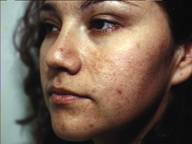
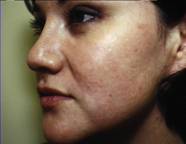
Some of the better treatments of acne scars were done with a combination of chemical peel (in this case 35% TCA and dermabrasion). We tend to use CO2 laser more often now.
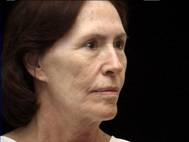
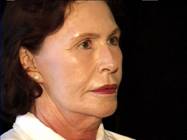
This patient had facial fat grafting performed and at the same time underwent a full face 35% TCA peel. It helped reduce some of the wrinkling.
More recently, there has been a surge of popularity toward the carbon dioxide and the erbium laser for "skin re-surfacing". "LASER" is an acronym for light amplification stimulated emission of radiation. Essentially, laser light is a very pure light source of uniform frequency (wave length). The new laser modalities essentially vaporize very superficial layers of the skin. The new skin is tighter and somewhat thicker with more collagen deposition. This is very similar to the way the chemical peel works. There seems to be a sense of better control with the laser versus the chemical peel or dermabrasion. Nonetheless, over-treatment is possible, which could result in scarring too. Results from laser treatment can be very satisfying, but with the carbon dioxide laser some people may experience long periods of redness (3 to 4 months) during the healing phase. The erbium laser causes considerably shorter periods of redness. Though the erbium acts similarly to the carbon dioxide laser, there is less heat distribution so it may be better for fine wrinkles while the carbon dioxide may be better for overall tightening. Make-up can be quite useful under those circumstances.
While I confess that I enjoy using the new carbon dioxide and erbium lasers for skin resurfacing, I'm a little bothered by all of the hype, particularly when doctors claim it is a non-surgical procedure. Maybe I have a misunderstanding about the criteria for surgery. I had always been taught that when a doctor physically alters some aspect of the body, whether entering it with a scalpel, or performing more superficial maneuvers, such as laser resurfacing, this constituted a surgical intervention. Nonetheless, vaporizing or burning the top layers of skin off one's face is hardly a completely benign procedure. Indeed, I can perform a face-lift on a younger patient and they are usually looking much better, much quicker than a laser patient.
The laser certainly has its place. And, today there are several types of lasers available depending upon what we wish to accomplish. The carbon dioxide laser is available in several different models, all of which have some minor advantage over the others, or so we are told. There are lasers that can remove tiny blood vessels and pigmented lesions. There are lasers which can remove tattoos. Some lasers are better than others for reducing scar tissue. Still, the laser is not a magic wand, but, rather, a very useful tool which is potentially helpful in a variety of specific cases.
Treatment following laser re-surfacing is pretty much the same as following a chemical peel or dermabrasion. The patient is kept on oral antibiotics and even oral anti-viral medication if there's a history of herpes or cold sores. A mild pain medication, such a Tylenol with codeine is usually adequate. The mainstay of post-operative care, however, involves the application of antibiotic ointment to help speed the wound healing. Frequent compressing with cool water is often recommended as well, particularly in the first 48 hours. Itching can be fairly bothersome in some patients and treatment is available in such cases. Generally, by the end of one week, the new skin is reasonably well healed. It may show persistent redness, but at this time a cover-up make-up can be applied and most people can resume fairly normal activities.
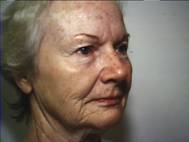
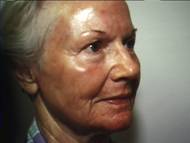
This patient has diffuse sun damage, wrinkling, age spots, and sagging skin. One month after CO2 laser re-surfacing, although still quite pink, her skin is tighter, most of the age spots have been removed and a lot of the fine lines are significantly diminished.
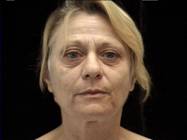
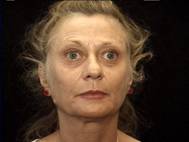
Three months following CO2 laser re-surfacing and facial fat-grafting. There is a marked reduction in facial wrinkles, much tightening of the skin and some filling as well. Further fat grafting can be done to continue to soften her appearance.
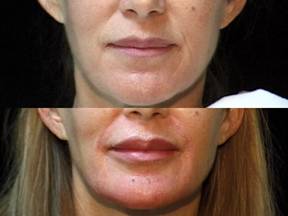
In this example, the Erbium laser was used along with fat grafting. One week after surgery there is less redness than CO2 laser after two months. It is probably not as effective in more severe cases.
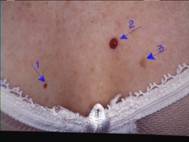
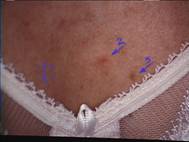
Not to be forgotten are the dye lasers, in this case the KTP laser which gives off a brilliant green light at 532 angstroms. It is absorbed into pigmented tissues. In this case, the red angiomas (no. 1 and 2) on the skin surface are removed in one sitting. No. 3, a small lentigo, is marked for reference.
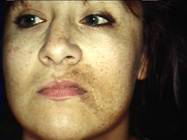
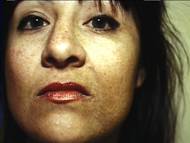
The KTP laser was also used in this difficult case, a nevus of Ota. After several treatments there is some lightening of the lesion as seen without make-up, which the patient can now where for further cover-up. The newer Versapulse lasers are probably the state of the art for some of these more difficult lesions.
Complications can occur with any of these treatments. Scarring is generally the result of over aggressive treatment. Trying to remove every line and wrinkle can sometimes result in excessive damage which yields thickened scar tissue. This may appear as an actual lump of tissue or as a smooth, glassy textured layer of skin. On the other hand, under-treatment can result in the failure to remove or adequately reduce skin wrinkling. As annoying as this might be to the patient, it is far preferable to over-treatment. Since a lot of these laser technologies continue to evolve at such rapid rates, conservative management will likely be applied by most physicians.
Changes in skin color is also a risk of any of these surgical modalities. In general, the deeper the penetration into the skin, the more likely the loss of pigmentation. CO2 laser and lighter peel solutions can usually be performed without losing pigmentation. On the other hand, during the healing phase, hyper (or increased) pigmentation is fairly common. In some patients it simply develops and is call post-inflammatory hyperpigmentation. In other cases, it is the result of inadvertent sun exposure. In either case, treatment with a combination of bleaching creams and retin-A or glycolic acid products can hasten the recovery. Finally, persistent redness can be quite aggravating. This generally follows more aggressive laser treatment and is not too annoying as long as it is expected.
Fees for laser re-surfacing may be from $3,000-5,000 and this should include anesthesia, operating room expense, laser fee and surgical expense. Chemical peels and dermabrasion are generally somewhat cheaper as there is less equipment and technological support staff involved.